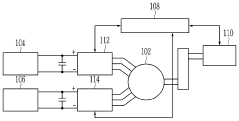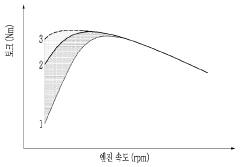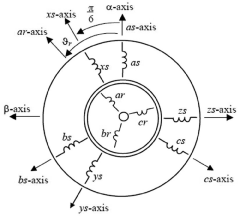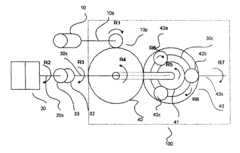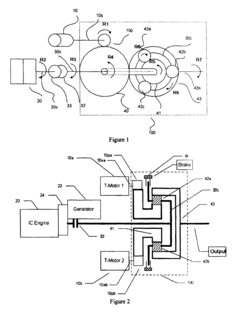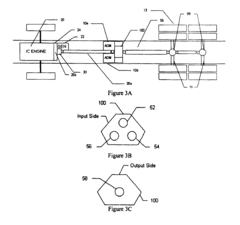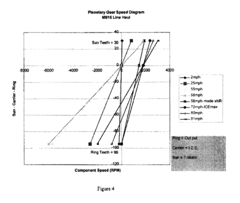The Competitive Landscape for HEV Technology Providers
AUG 14, 20259 MIN READ
Generate Your Research Report Instantly with AI Agent
Patsnap Eureka helps you evaluate technical feasibility & market potential.
HEV Tech Evolution and Objectives
Hybrid Electric Vehicle (HEV) technology has evolved significantly since its inception in the late 20th century. The primary objective of HEV technology has been to reduce fuel consumption and emissions while maintaining or improving vehicle performance. This evolution has been driven by a combination of environmental concerns, regulatory pressures, and consumer demand for more efficient transportation options.
The development of HEV technology can be traced back to the 1990s when major automakers began exploring alternatives to traditional internal combustion engines. The initial focus was on improving fuel efficiency and reducing emissions without sacrificing the convenience and range that consumers had come to expect from conventional vehicles. This led to the development of parallel hybrid systems, where both the electric motor and the internal combustion engine could directly power the wheels.
As the technology progressed, series hybrid systems emerged, allowing for more efficient energy management by using the internal combustion engine primarily as a generator to charge the battery pack. This configuration enabled vehicles to operate in pure electric mode for short distances, further reducing emissions in urban environments. The introduction of plug-in hybrid electric vehicles (PHEVs) in the mid-2000s marked another significant milestone, allowing users to charge their vehicles from the electrical grid and potentially operate in all-electric mode for longer distances.
The objectives of HEV technology have expanded beyond mere fuel efficiency. Modern HEVs aim to provide a seamless driving experience, with smooth transitions between electric and combustion power sources. Enhanced performance through instant torque delivery from electric motors has become a key selling point. Additionally, HEVs are increasingly seen as a stepping stone towards full electrification, serving as a bridge technology that familiarizes consumers with electric powertrains while alleviating range anxiety.
Recent technological advancements have focused on improving battery technology, power electronics, and energy management systems. The goal is to increase electric range, reduce charging times, and optimize the integration of electric and combustion power sources. Manufacturers are also exploring the use of advanced materials to reduce vehicle weight, further enhancing efficiency and performance.
Looking forward, the objectives of HEV technology providers include developing more compact and efficient powertrains, improving battery longevity and recyclability, and reducing production costs to make HEVs more accessible to a broader market. There is also a growing emphasis on integrating HEVs with smart grid technologies and exploring vehicle-to-grid (V2G) capabilities, potentially allowing HEVs to serve as distributed energy storage units in the broader energy ecosystem.
The development of HEV technology can be traced back to the 1990s when major automakers began exploring alternatives to traditional internal combustion engines. The initial focus was on improving fuel efficiency and reducing emissions without sacrificing the convenience and range that consumers had come to expect from conventional vehicles. This led to the development of parallel hybrid systems, where both the electric motor and the internal combustion engine could directly power the wheels.
As the technology progressed, series hybrid systems emerged, allowing for more efficient energy management by using the internal combustion engine primarily as a generator to charge the battery pack. This configuration enabled vehicles to operate in pure electric mode for short distances, further reducing emissions in urban environments. The introduction of plug-in hybrid electric vehicles (PHEVs) in the mid-2000s marked another significant milestone, allowing users to charge their vehicles from the electrical grid and potentially operate in all-electric mode for longer distances.
The objectives of HEV technology have expanded beyond mere fuel efficiency. Modern HEVs aim to provide a seamless driving experience, with smooth transitions between electric and combustion power sources. Enhanced performance through instant torque delivery from electric motors has become a key selling point. Additionally, HEVs are increasingly seen as a stepping stone towards full electrification, serving as a bridge technology that familiarizes consumers with electric powertrains while alleviating range anxiety.
Recent technological advancements have focused on improving battery technology, power electronics, and energy management systems. The goal is to increase electric range, reduce charging times, and optimize the integration of electric and combustion power sources. Manufacturers are also exploring the use of advanced materials to reduce vehicle weight, further enhancing efficiency and performance.
Looking forward, the objectives of HEV technology providers include developing more compact and efficient powertrains, improving battery longevity and recyclability, and reducing production costs to make HEVs more accessible to a broader market. There is also a growing emphasis on integrating HEVs with smart grid technologies and exploring vehicle-to-grid (V2G) capabilities, potentially allowing HEVs to serve as distributed energy storage units in the broader energy ecosystem.
HEV Market Demand Analysis
The global market for Hybrid Electric Vehicles (HEVs) has experienced significant growth in recent years, driven by increasing environmental concerns, stricter emissions regulations, and rising fuel costs. Consumer demand for more fuel-efficient and environmentally friendly vehicles has been a key factor in the expansion of the HEV market.
In developed markets such as North America, Europe, and Japan, HEVs have gained substantial market share. These regions have seen a steady increase in HEV adoption due to well-established infrastructure, government incentives, and higher consumer awareness of environmental issues. The United States, in particular, has witnessed a surge in HEV sales, with major automakers expanding their hybrid vehicle offerings to meet growing demand.
Emerging markets, including China and India, are also showing promising growth potential for HEVs. As these countries grapple with severe air pollution and implement stricter emissions standards, there is an increasing shift towards cleaner transportation options. The rising middle class in these markets is also contributing to the demand for HEVs, as consumers seek more sophisticated and eco-friendly vehicles.
The commercial sector presents another significant area of growth for HEV technology. Fleet operators, including taxi services, delivery companies, and public transportation agencies, are increasingly adopting hybrid vehicles to reduce operational costs and meet sustainability goals. This trend is expected to continue as businesses face pressure to reduce their carbon footprint and comply with evolving environmental regulations.
Market analysis indicates that the global HEV market is projected to grow at a compound annual growth rate (CAGR) of over 8% in the coming years. This growth is attributed to factors such as technological advancements, decreasing battery costs, and expanding charging infrastructure. The increasing variety of HEV models across different vehicle segments, from compact cars to SUVs, is also contributing to market expansion by catering to diverse consumer preferences.
Consumer surveys reveal that fuel efficiency, environmental impact, and long-term cost savings are the primary drivers for HEV purchases. However, challenges such as higher initial costs compared to conventional vehicles and limited driving range for plug-in hybrid models remain barriers to wider adoption. As technology improves and economies of scale are achieved, these barriers are expected to diminish, further accelerating market growth.
The HEV market is also influenced by government policies and regulations. Many countries have implemented incentives such as tax credits, rebates, and preferential parking to promote HEV adoption. Additionally, stricter fuel economy standards and emissions regulations are pushing automakers to invest more heavily in hybrid technology, further driving market growth and innovation in the HEV sector.
In developed markets such as North America, Europe, and Japan, HEVs have gained substantial market share. These regions have seen a steady increase in HEV adoption due to well-established infrastructure, government incentives, and higher consumer awareness of environmental issues. The United States, in particular, has witnessed a surge in HEV sales, with major automakers expanding their hybrid vehicle offerings to meet growing demand.
Emerging markets, including China and India, are also showing promising growth potential for HEVs. As these countries grapple with severe air pollution and implement stricter emissions standards, there is an increasing shift towards cleaner transportation options. The rising middle class in these markets is also contributing to the demand for HEVs, as consumers seek more sophisticated and eco-friendly vehicles.
The commercial sector presents another significant area of growth for HEV technology. Fleet operators, including taxi services, delivery companies, and public transportation agencies, are increasingly adopting hybrid vehicles to reduce operational costs and meet sustainability goals. This trend is expected to continue as businesses face pressure to reduce their carbon footprint and comply with evolving environmental regulations.
Market analysis indicates that the global HEV market is projected to grow at a compound annual growth rate (CAGR) of over 8% in the coming years. This growth is attributed to factors such as technological advancements, decreasing battery costs, and expanding charging infrastructure. The increasing variety of HEV models across different vehicle segments, from compact cars to SUVs, is also contributing to market expansion by catering to diverse consumer preferences.
Consumer surveys reveal that fuel efficiency, environmental impact, and long-term cost savings are the primary drivers for HEV purchases. However, challenges such as higher initial costs compared to conventional vehicles and limited driving range for plug-in hybrid models remain barriers to wider adoption. As technology improves and economies of scale are achieved, these barriers are expected to diminish, further accelerating market growth.
The HEV market is also influenced by government policies and regulations. Many countries have implemented incentives such as tax credits, rebates, and preferential parking to promote HEV adoption. Additionally, stricter fuel economy standards and emissions regulations are pushing automakers to invest more heavily in hybrid technology, further driving market growth and innovation in the HEV sector.
HEV Tech Challenges and Limitations
Hybrid Electric Vehicle (HEV) technology, while promising, faces several significant challenges and limitations that hinder its widespread adoption and technological advancement. One of the primary obstacles is the complexity of integrating two distinct power sources - an internal combustion engine and an electric motor - into a single, efficient system. This integration requires sophisticated control systems and power management algorithms to optimize performance and fuel efficiency, which can be costly to develop and implement.
Battery technology remains a critical limitation for HEVs. Current battery systems often struggle with issues of energy density, charging speed, and longevity. The limited capacity of batteries restricts the all-electric driving range of HEVs, reducing their appeal to consumers seeking extended zero-emission driving capabilities. Additionally, the high cost of advanced battery technologies contributes significantly to the overall price of HEVs, making them less competitive in the market compared to conventional vehicles.
Thermal management is another substantial challenge for HEV technology providers. The combination of an internal combustion engine and electric components generates significant heat, requiring complex cooling systems to maintain optimal operating temperatures. Ineffective thermal management can lead to reduced performance, decreased battery life, and potential safety issues.
Weight management presents an ongoing challenge for HEV designers. The addition of electric components, particularly the battery pack, increases the overall weight of the vehicle. This added weight can negatively impact fuel efficiency and vehicle dynamics, potentially offsetting some of the gains achieved through hybridization.
Manufacturing complexity and supply chain management pose significant hurdles for HEV technology providers. The production of HEVs requires specialized components and manufacturing processes, which can be more costly and complex than those for conventional vehicles. Securing a stable supply of critical components, such as rare earth metals for electric motors and advanced materials for batteries, can be challenging and subject to geopolitical factors.
Standardization and compatibility issues also present challenges in the HEV market. The lack of universal standards for charging infrastructure, battery systems, and other key components can lead to fragmentation in the market and hinder interoperability between different manufacturers' systems.
Lastly, the rapid pace of technological advancement in the automotive industry poses a challenge for HEV technology providers. As fully electric vehicles continue to improve in range and affordability, and as alternative technologies like fuel cells gain traction, HEV technology risks becoming a transitional solution rather than a long-term answer to sustainable transportation. This uncertainty can impact investment decisions and long-term strategic planning for companies in the HEV space.
Battery technology remains a critical limitation for HEVs. Current battery systems often struggle with issues of energy density, charging speed, and longevity. The limited capacity of batteries restricts the all-electric driving range of HEVs, reducing their appeal to consumers seeking extended zero-emission driving capabilities. Additionally, the high cost of advanced battery technologies contributes significantly to the overall price of HEVs, making them less competitive in the market compared to conventional vehicles.
Thermal management is another substantial challenge for HEV technology providers. The combination of an internal combustion engine and electric components generates significant heat, requiring complex cooling systems to maintain optimal operating temperatures. Ineffective thermal management can lead to reduced performance, decreased battery life, and potential safety issues.
Weight management presents an ongoing challenge for HEV designers. The addition of electric components, particularly the battery pack, increases the overall weight of the vehicle. This added weight can negatively impact fuel efficiency and vehicle dynamics, potentially offsetting some of the gains achieved through hybridization.
Manufacturing complexity and supply chain management pose significant hurdles for HEV technology providers. The production of HEVs requires specialized components and manufacturing processes, which can be more costly and complex than those for conventional vehicles. Securing a stable supply of critical components, such as rare earth metals for electric motors and advanced materials for batteries, can be challenging and subject to geopolitical factors.
Standardization and compatibility issues also present challenges in the HEV market. The lack of universal standards for charging infrastructure, battery systems, and other key components can lead to fragmentation in the market and hinder interoperability between different manufacturers' systems.
Lastly, the rapid pace of technological advancement in the automotive industry poses a challenge for HEV technology providers. As fully electric vehicles continue to improve in range and affordability, and as alternative technologies like fuel cells gain traction, HEV technology risks becoming a transitional solution rather than a long-term answer to sustainable transportation. This uncertainty can impact investment decisions and long-term strategic planning for companies in the HEV space.
Current HEV Powertrain Solutions
01 HEV light protection in cosmetics
High Energy Visible (HEV) light protection technology is being incorporated into cosmetic formulations. This involves the use of specific ingredients that can absorb or reflect HEV light, which is known to contribute to skin aging and damage. These formulations aim to provide a comprehensive approach to skin protection beyond traditional UV filters.- HEV light protection in cosmetics: High Energy Visible (HEV) light protection technology is being incorporated into cosmetic formulations. This involves developing ingredients and compounds that can shield the skin from the potentially harmful effects of blue light emitted by electronic devices and sunlight. These formulations aim to prevent skin damage, premature aging, and hyperpigmentation caused by HEV light exposure.
- HEV-resistant display technologies: Advancements in display technologies focus on reducing the emission of High Energy Visible light from screens. This includes developing filters, coatings, and specialized materials that can be integrated into displays to minimize HEV light output without compromising image quality. These technologies aim to protect users' eyes and skin from prolonged exposure to HEV light emitted by electronic devices.
- HEV light measurement and detection: Technologies for accurately measuring and detecting High Energy Visible light are being developed. These include specialized sensors, spectrophotometers, and other instruments designed to quantify HEV light levels in various environments. Such tools are crucial for research, product development, and ensuring compliance with safety standards related to HEV light exposure.
- HEV-related genetic and biological research: Research is being conducted to understand the genetic and biological effects of High Energy Visible light exposure. This includes studying how HEV light interacts with cellular processes, DNA, and various biological systems. The findings from this research contribute to the development of more effective protection strategies and treatments for HEV light-induced damage.
- HEV light applications in agriculture and horticulture: High Energy Visible light technology is being explored for its potential benefits in agriculture and horticulture. This includes developing specialized lighting systems that utilize specific wavelengths of HEV light to enhance plant growth, increase crop yields, and improve the nutritional content of produce. These applications aim to optimize plant cultivation in both traditional and controlled environment agriculture.
02 HEV-blocking materials in electronic displays
HEV technology is being applied to electronic displays to reduce the emission of high-energy visible light. This involves the development of special filters or coatings that can be applied to screens to block or reduce HEV light emission, potentially reducing eye strain and sleep disturbances associated with prolonged screen use.Expand Specific Solutions03 HEV light therapy applications
HEV light is being utilized in therapeutic applications. This technology involves controlled exposure to specific wavelengths of HEV light for various health benefits, including treatment of skin conditions, mood disorders, and sleep regulation. Devices are being developed to deliver precise doses of HEV light for these purposes.Expand Specific Solutions04 HEV-related genetic research
Research is being conducted on the genetic effects of HEV light exposure. This involves studying how HEV light interacts with DNA and cellular processes, potentially leading to new understandings of light-induced cellular damage and repair mechanisms. This research may inform future protective technologies and treatments.Expand Specific Solutions05 HEV technology in automotive applications
HEV technology is being integrated into automotive systems, particularly in lighting and display applications. This includes the development of HEV-optimized headlights for improved visibility and safety, as well as HEV-considerate interior lighting and display systems to enhance driver comfort and reduce fatigue during night driving.Expand Specific Solutions
Key HEV Technology Providers
The competitive landscape for HEV technology providers is characterized by a mature market with significant growth potential. Major automotive manufacturers like Hyundai, Kia, Ford, GM, and Honda are leading players, investing heavily in HEV development. The market is experiencing rapid expansion due to increasing environmental concerns and government regulations. Technological advancements from companies such as Guangzhou Automobile Group and Mahindra & Mahindra are driving innovation in battery efficiency and powertrain systems. Research institutions like South China University of Technology and Chongqing University are contributing to the field through collaborative projects and academic research, further accelerating the technology's evolution and market adoption.
Hyundai Motor Co., Ltd.
Technical Solution: Hyundai has developed a cutting-edge Hybrid Electric Vehicle (HEV) technology called the Hybrid-Electric Active Shift Control (ASC) system. This innovative technology utilizes the electric motor to align the rotational speeds of the engine and transmission, enabling faster gear shifts and improving fuel efficiency. The system reduces gear shift time by 30% compared to conventional hybrid powertrains[1]. Hyundai's HEV technology also incorporates a Continuously Variable Valve Duration (CVVD) engine, which optimizes both power and efficiency by adjusting the duration of valve opening and closing according to driving conditions[2]. Additionally, Hyundai has introduced a predictive energy management system that uses real-time traffic and road condition data to optimize the use of electric and combustion power, further enhancing fuel economy and reducing emissions[3].
Strengths: Advanced gear shift technology, innovative valve control system, and predictive energy management. Weaknesses: Potential complexity in manufacturing and maintenance, higher initial costs compared to conventional powertrains.
Ford Global Technologies LLC
Technical Solution: Ford has developed a sophisticated HEV technology platform called PowerSplit. This system utilizes a planetary gear set to combine power from the electric motor and internal combustion engine, allowing for seamless transitions between electric, hybrid, and engine-only modes. Ford's HEV technology incorporates an advanced battery management system that optimizes battery life and performance through intelligent charging and discharging strategies[4]. The company has also implemented a regenerative braking system that can capture up to 94% of braking energy, significantly improving overall energy efficiency[5]. Ford's HEV technology includes an EcoGuide cluster display that provides real-time feedback to drivers, encouraging more efficient driving habits and maximizing fuel economy. Additionally, Ford has developed a thermal management system that uses waste heat from the engine to warm the cabin, reducing the load on the electric battery and extending electric-only driving range[6].
Strengths: Efficient power distribution, advanced battery management, and high-performance regenerative braking. Weaknesses: Complexity of the planetary gear system may lead to higher maintenance costs.
HEV Battery Innovations
Hybrid electric vehicle with double-stator electric motor powered by battery and supercapacitor
PatentPendingKR1020220149439A
Innovation
- A hybrid electric vehicle system utilizing a double stator electric motor powered by a lithium-ion battery and supercapacitor, where the motor is supplied by two independent power sources, with a motor controller managing power distribution based on driver demand, temperature, and energy storage.
Power combining apparatus for hybrid electric vehicle
PatentInactiveUSRE41034E1
Innovation
- A vehicle transmission system utilizing a planetary gear set with a clutch and brake mechanism, enabling operation in three modes: mechanical, electrical, and combined, with a torque transmitting arrangement to synchronize power sources and optimize power transmission efficiency.
HEV Environmental Impact
The environmental impact of Hybrid Electric Vehicles (HEVs) is a critical consideration in the competitive landscape for HEV technology providers. These vehicles offer significant potential for reducing greenhouse gas emissions and improving air quality, particularly in urban areas where traffic congestion is a major concern.
HEVs combine conventional internal combustion engines with electric propulsion systems, resulting in improved fuel efficiency and reduced emissions compared to traditional vehicles. The electric motor assists the gasoline engine during acceleration and at low speeds, while regenerative braking systems capture energy typically lost during deceleration, further enhancing efficiency.
One of the primary environmental benefits of HEVs is their reduced carbon footprint. Studies have shown that HEVs can emit up to 30-50% less CO2 than conventional vehicles, depending on driving conditions and vehicle models. This reduction in greenhouse gas emissions contributes to mitigating climate change and helps countries meet their carbon reduction targets.
In addition to lower CO2 emissions, HEVs also produce fewer pollutants such as nitrogen oxides (NOx) and particulate matter. These reductions in local air pollutants can have significant positive impacts on public health, particularly in densely populated urban areas where air quality is often poor.
The manufacturing process of HEVs, however, does present some environmental challenges. The production of batteries and electric motors requires the extraction and processing of rare earth elements and other materials, which can have negative environmental impacts if not managed responsibly. Technology providers are increasingly focusing on developing more sustainable manufacturing processes and improving battery recycling techniques to address these concerns.
The overall lifecycle environmental impact of HEVs is generally favorable compared to conventional vehicles. While the production phase may have a higher environmental footprint due to battery manufacturing, the reduced emissions and improved efficiency during the use phase typically offset this initial impact over the vehicle's lifetime.
As HEV technology continues to evolve, providers are working on further improving environmental performance. This includes developing more efficient electric motors, enhancing battery technology for longer electric-only driving ranges, and exploring the use of sustainable materials in vehicle construction. These advancements not only contribute to reducing environmental impact but also serve as key differentiators in the competitive landscape for HEV technology providers.
HEVs combine conventional internal combustion engines with electric propulsion systems, resulting in improved fuel efficiency and reduced emissions compared to traditional vehicles. The electric motor assists the gasoline engine during acceleration and at low speeds, while regenerative braking systems capture energy typically lost during deceleration, further enhancing efficiency.
One of the primary environmental benefits of HEVs is their reduced carbon footprint. Studies have shown that HEVs can emit up to 30-50% less CO2 than conventional vehicles, depending on driving conditions and vehicle models. This reduction in greenhouse gas emissions contributes to mitigating climate change and helps countries meet their carbon reduction targets.
In addition to lower CO2 emissions, HEVs also produce fewer pollutants such as nitrogen oxides (NOx) and particulate matter. These reductions in local air pollutants can have significant positive impacts on public health, particularly in densely populated urban areas where air quality is often poor.
The manufacturing process of HEVs, however, does present some environmental challenges. The production of batteries and electric motors requires the extraction and processing of rare earth elements and other materials, which can have negative environmental impacts if not managed responsibly. Technology providers are increasingly focusing on developing more sustainable manufacturing processes and improving battery recycling techniques to address these concerns.
The overall lifecycle environmental impact of HEVs is generally favorable compared to conventional vehicles. While the production phase may have a higher environmental footprint due to battery manufacturing, the reduced emissions and improved efficiency during the use phase typically offset this initial impact over the vehicle's lifetime.
As HEV technology continues to evolve, providers are working on further improving environmental performance. This includes developing more efficient electric motors, enhancing battery technology for longer electric-only driving ranges, and exploring the use of sustainable materials in vehicle construction. These advancements not only contribute to reducing environmental impact but also serve as key differentiators in the competitive landscape for HEV technology providers.
HEV Policy and Regulations
The regulatory landscape for Hybrid Electric Vehicle (HEV) technology is rapidly evolving, with governments worldwide implementing policies to promote the adoption of cleaner transportation solutions. These regulations are primarily driven by the need to reduce greenhouse gas emissions and improve air quality in urban areas.
In the United States, the Corporate Average Fuel Economy (CAFE) standards have been a significant driver for HEV adoption. These standards require automakers to achieve increasingly stringent fleet-wide fuel efficiency targets, incentivizing the development and production of hybrid vehicles. Additionally, the federal government offers tax credits for the purchase of certain hybrid vehicles, further stimulating consumer demand.
The European Union has implemented strict CO2 emission standards for new passenger cars and light commercial vehicles. These regulations have led to a surge in HEV development and sales across European markets. The EU's target of reducing CO2 emissions from new cars by 37.5% by 2030 compared to 2021 levels has created a strong impetus for automakers to invest in hybrid technology.
China, the world's largest automotive market, has also introduced policies to promote HEV adoption. The country's New Energy Vehicle (NEV) credit system requires automakers to produce a certain percentage of low-emission vehicles, including hybrids. This policy has spurred significant investment in HEV technology by both domestic and international manufacturers operating in the Chinese market.
Japan, a pioneer in hybrid technology, continues to support HEV development through various incentives and regulations. The country's Top Runner Program sets efficiency standards for vehicles, encouraging the adoption of hybrid powertrains. Japan also offers tax breaks and subsidies for the purchase of environmentally friendly vehicles, including HEVs.
Many other countries have implemented similar policies to promote HEV adoption. These include preferential tax treatments, subsidies, and infrastructure development initiatives. For instance, Norway offers significant tax incentives for hybrid vehicles, while India has implemented the Faster Adoption and Manufacturing of Hybrid and Electric Vehicles (FAME) scheme to boost HEV sales.
The global trend towards stricter emission standards and fuel efficiency requirements is expected to continue, further shaping the competitive landscape for HEV technology providers. Companies that can develop cost-effective, high-performance hybrid powertrains will be well-positioned to capitalize on these regulatory trends and gain market share in the rapidly growing HEV segment.
In the United States, the Corporate Average Fuel Economy (CAFE) standards have been a significant driver for HEV adoption. These standards require automakers to achieve increasingly stringent fleet-wide fuel efficiency targets, incentivizing the development and production of hybrid vehicles. Additionally, the federal government offers tax credits for the purchase of certain hybrid vehicles, further stimulating consumer demand.
The European Union has implemented strict CO2 emission standards for new passenger cars and light commercial vehicles. These regulations have led to a surge in HEV development and sales across European markets. The EU's target of reducing CO2 emissions from new cars by 37.5% by 2030 compared to 2021 levels has created a strong impetus for automakers to invest in hybrid technology.
China, the world's largest automotive market, has also introduced policies to promote HEV adoption. The country's New Energy Vehicle (NEV) credit system requires automakers to produce a certain percentage of low-emission vehicles, including hybrids. This policy has spurred significant investment in HEV technology by both domestic and international manufacturers operating in the Chinese market.
Japan, a pioneer in hybrid technology, continues to support HEV development through various incentives and regulations. The country's Top Runner Program sets efficiency standards for vehicles, encouraging the adoption of hybrid powertrains. Japan also offers tax breaks and subsidies for the purchase of environmentally friendly vehicles, including HEVs.
Many other countries have implemented similar policies to promote HEV adoption. These include preferential tax treatments, subsidies, and infrastructure development initiatives. For instance, Norway offers significant tax incentives for hybrid vehicles, while India has implemented the Faster Adoption and Manufacturing of Hybrid and Electric Vehicles (FAME) scheme to boost HEV sales.
The global trend towards stricter emission standards and fuel efficiency requirements is expected to continue, further shaping the competitive landscape for HEV technology providers. Companies that can develop cost-effective, high-performance hybrid powertrains will be well-positioned to capitalize on these regulatory trends and gain market share in the rapidly growing HEV segment.
Unlock deeper insights with Patsnap Eureka Quick Research — get a full tech report to explore trends and direct your research. Try now!
Generate Your Research Report Instantly with AI Agent
Supercharge your innovation with Patsnap Eureka AI Agent Platform!
